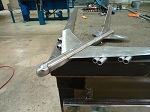Router bit on aluminum?
18 posts
• Page 1 of 2 • 1, 2
Router bit on aluminum?
Before I try it and possibly hurt myself or a bit I thought I would ask if anybody has done it before. Will be done on 5052 H-34 .063".
Randy
Aircraft fabricator, novice carpenter, electrical apprentice, audio engineer dropout.
Build thread - http://www.tnttt.com/viewtopic.php?f=50&t=54126
Aircraft fabricator, novice carpenter, electrical apprentice, audio engineer dropout.
Build thread - http://www.tnttt.com/viewtopic.php?f=50&t=54126
-

RandyG - 500 Club
- Posts: 695
- Images: 115
- Joined: Thu May 10, 2012 6:52 pm
Re: Router bit on aluminum?
Yep, sure have and I had no problem.Just be sure to use some common sense and be safety minded. 





Remember 'Teardrop Time'.......Take your time, you don't have to have it finished NOW.
-

Gage - 8000 Club

- Posts: 8321
- Images: 28
- Joined: Sat Apr 17, 2004 9:14 pm
- Location: Palmdale, CA






